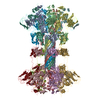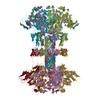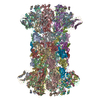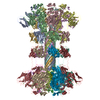[English] 日本語
 Yorodumi
Yorodumi- PDB-6o2o: CDTb Double Heptamer Short Form Modeled from Cryo-EM Map Reconstr... -
+ Open data
Open data
- Basic information
Basic information
| Entry | Database: PDB / ID: 6o2o | |||||||||
|---|---|---|---|---|---|---|---|---|---|---|
| Title | CDTb Double Heptamer Short Form Modeled from Cryo-EM Map Reconstructed using C1 Symmetry | |||||||||
 Components Components | ADP-ribosyltransferase binding component | |||||||||
 Keywords Keywords | TRANSFERASE / CDTb / Toxin / Binary / difficile | |||||||||
| Function / homology |  Function and homology information Function and homology informationprotein homooligomerization / transferase activity / extracellular region / metal ion binding / identical protein binding Similarity search - Function | |||||||||
| Biological species |  Clostridioides difficile (bacteria) Clostridioides difficile (bacteria) | |||||||||
| Method | ELECTRON MICROSCOPY / single particle reconstruction / cryo EM / Resolution: 4.53 Å | |||||||||
 Authors Authors | Lacy, D.B. / Sheedlo, M.J. / Anderson, D.M. | |||||||||
| Funding support |  United States, 2items United States, 2items
| |||||||||
 Citation Citation |  Journal: Nat Microbiol / Year: 2020 Journal: Nat Microbiol / Year: 2020Title: Structural insights into the transition of Clostridioides difficile binary toxin from prepore to pore. Authors: David M Anderson / Michael J Sheedlo / Jaime L Jensen / D Borden Lacy /  Abstract: Clostridioides (formerly Clostridium) difficile is a Gram-positive, spore-forming anaerobe and a leading cause of hospital-acquired infection and gastroenteritis-associated death in US hospitals. The ...Clostridioides (formerly Clostridium) difficile is a Gram-positive, spore-forming anaerobe and a leading cause of hospital-acquired infection and gastroenteritis-associated death in US hospitals. The disease state is usually preceded by disruption of the host microbiome in response to antibiotic treatment and is characterized by mild to severe diarrhoea. C. difficile infection is dependent on the secretion of one or more AB-type toxins: toxin A (TcdA), toxin B (TcdB) and the C. difficile transferase toxin (CDT). Whereas TcdA and TcdB are considered the primary virulence factors, recent studies suggest that CDT increases the severity of C. difficile infection in some of the most problematic clinical strains. To better understand how CDT functions, we used cryo-electron microscopy to define the structure of CDTb, the cell-binding component of CDT. We obtained structures of several oligomeric forms that highlight the conformational changes that enable conversion from a prepore to a β-barrel pore. The structural analysis also reveals a glycan-binding domain and residues involved in binding the host-cell receptor, lipolysis-stimulated lipoprotein receptor. Together, these results provide a framework to understand how CDT functions at the host cell interface. | |||||||||
| History |
|
- Structure visualization
Structure visualization
| Movie |
 Movie viewer Movie viewer |
|---|---|
| Structure viewer | Molecule:  Molmil Molmil Jmol/JSmol Jmol/JSmol |
- Downloads & links
Downloads & links
- Download
Download
| PDBx/mmCIF format |  6o2o.cif.gz 6o2o.cif.gz | 1.6 MB | Display |  PDBx/mmCIF format PDBx/mmCIF format |
|---|---|---|---|---|
| PDB format |  pdb6o2o.ent.gz pdb6o2o.ent.gz | 1.3 MB | Display |  PDB format PDB format |
| PDBx/mmJSON format |  6o2o.json.gz 6o2o.json.gz | Tree view |  PDBx/mmJSON format PDBx/mmJSON format | |
| Others |  Other downloads Other downloads |
-Validation report
| Summary document |  6o2o_validation.pdf.gz 6o2o_validation.pdf.gz | 1.2 MB | Display |  wwPDB validaton report wwPDB validaton report |
|---|---|---|---|---|
| Full document |  6o2o_full_validation.pdf.gz 6o2o_full_validation.pdf.gz | 1.3 MB | Display | |
| Data in XML |  6o2o_validation.xml.gz 6o2o_validation.xml.gz | 229.9 KB | Display | |
| Data in CIF |  6o2o_validation.cif.gz 6o2o_validation.cif.gz | 349.9 KB | Display | |
| Arichive directory |  https://data.pdbj.org/pub/pdb/validation_reports/o2/6o2o https://data.pdbj.org/pub/pdb/validation_reports/o2/6o2o ftp://data.pdbj.org/pub/pdb/validation_reports/o2/6o2o ftp://data.pdbj.org/pub/pdb/validation_reports/o2/6o2o | HTTPS FTP |
-Related structure data
| Related structure data |  0610MC  0608C  0609C  6o2mC  6o2nC  6okrC  6oksC  6oktC  6okuC M: map data used to model this data C: citing same article ( |
|---|---|
| Similar structure data |
- Links
Links
- Assembly
Assembly
| Deposited unit | 
|
|---|---|
| 1 |
|
- Components
Components
| #1: Protein | Mass: 98916.828 Da / Num. of mol.: 14 Source method: isolated from a genetically manipulated source Source: (gene. exp.)  Clostridioides difficile (bacteria) / Gene: cdtB / Production host: Clostridioides difficile (bacteria) / Gene: cdtB / Production host:  |
|---|
-Experimental details
-Experiment
| Experiment | Method: ELECTRON MICROSCOPY |
|---|---|
| EM experiment | Aggregation state: PARTICLE / 3D reconstruction method: single particle reconstruction |
- Sample preparation
Sample preparation
| Component | Name: CDTb / Type: COMPLEX / Entity ID: all / Source: RECOMBINANT |
|---|---|
| Molecular weight | Experimental value: NO |
| Source (natural) | Organism:  Clostridioides difficile (bacteria) Clostridioides difficile (bacteria) |
| Source (recombinant) | Organism:  |
| Buffer solution | pH: 8 |
| Specimen | Embedding applied: NO / Shadowing applied: NO / Staining applied: NO / Vitrification applied: YES |
| Specimen support | Grid material: COPPER / Grid mesh size: 400 divisions/in. / Grid type: Quantifoil R2/1 |
| Vitrification | Instrument: FEI VITROBOT MARK IV / Cryogen name: ETHANE / Humidity: 100 % / Chamber temperature: 293 K |
- Electron microscopy imaging
Electron microscopy imaging
| Experimental equipment |  Model: Titan Krios / Image courtesy: FEI Company |
|---|---|
| Microscopy | Model: FEI TITAN KRIOS |
| Electron gun | Electron source:  FIELD EMISSION GUN / Accelerating voltage: 300 kV / Illumination mode: FLOOD BEAM FIELD EMISSION GUN / Accelerating voltage: 300 kV / Illumination mode: FLOOD BEAM |
| Electron lens | Mode: BRIGHT FIELD |
| Specimen holder | Cryogen: NITROGEN |
| Image recording | Average exposure time: 9.6 sec. / Electron dose: 110.1 e/Å2 / Film or detector model: GATAN K2 SUMMIT (4k x 4k) / Num. of grids imaged: 2 / Num. of real images: 4914 |
| EM imaging optics | Energyfilter name: GIF Bioquantum / Energyfilter slit width: 20 eV |
- Processing
Processing
| EM software |
| |||||||||||||||
|---|---|---|---|---|---|---|---|---|---|---|---|---|---|---|---|---|
| CTF correction | Type: PHASE FLIPPING AND AMPLITUDE CORRECTION | |||||||||||||||
| Symmetry | Point symmetry: C1 (asymmetric) | |||||||||||||||
| 3D reconstruction | Resolution: 4.53 Å / Resolution method: FSC 0.143 CUT-OFF / Num. of particles: 12306 / Symmetry type: POINT | |||||||||||||||
| Atomic model building | Protocol: AB INITIO MODEL / Space: REAL |
 Movie
Movie Controller
Controller










 PDBj
PDBj
